|
House plant cacti and succulents are an
interesting group of plants. All cacti are succulents, but not all
succulents are cacti. A succulent is a plant that stores water in its
stems or leaves. The stored water is used by the plant during
prolonged dry periods. What makes a cactus a cactus and distinguishes
it from a succulent is a tuft of fine spines called an
"aerole." The aerole ranges in size from barely noticeable
to up to a quarter of an inch across. The aeroles are usually
arranged in rows on the cactus' stems. This is where spines and
flowers grow. Spines are the cactus' natural defenses against
predators in the wild.
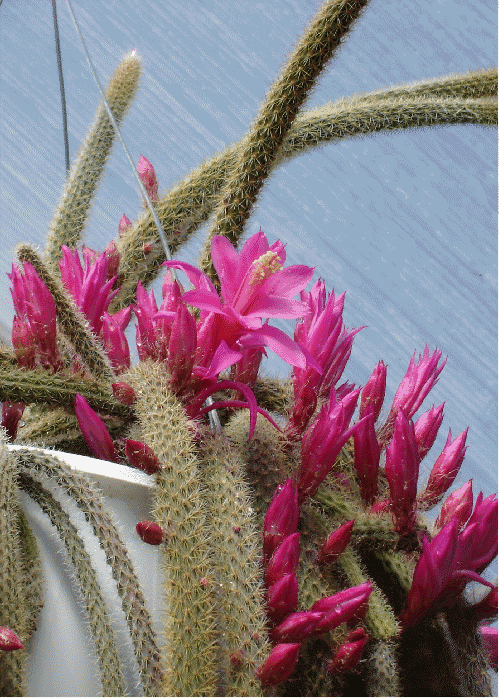 There
are many different types of house plant cacti. They are divided into
different categories based on their individual shapes including
flattened and segmented, candelabra, columnar, cylindrical with
leaves, pendant, clustering, star shaped, globular, globular with
"chins," and pincushion. Rattail
cactus is an example of a pendant shape. Long,
slender, trailing stems hang gracefully downward on this handsome
cactus. Soft, white spines line its gray-green stems. In spring, its
stems bear dozens and dozens of fuchsia-pink tubular flowers that
stand perpendicular to the stems. The flowers are up to two inches
long and are in bloom for weeks. There
are many different types of house plant cacti. They are divided into
different categories based on their individual shapes including
flattened and segmented, candelabra, columnar, cylindrical with
leaves, pendant, clustering, star shaped, globular, globular with
"chins," and pincushion. Rattail
cactus is an example of a pendant shape. Long,
slender, trailing stems hang gracefully downward on this handsome
cactus. Soft, white spines line its gray-green stems. In spring, its
stems bear dozens and dozens of fuchsia-pink tubular flowers that
stand perpendicular to the stems. The flowers are up to two inches
long and are in bloom for weeks. |
|
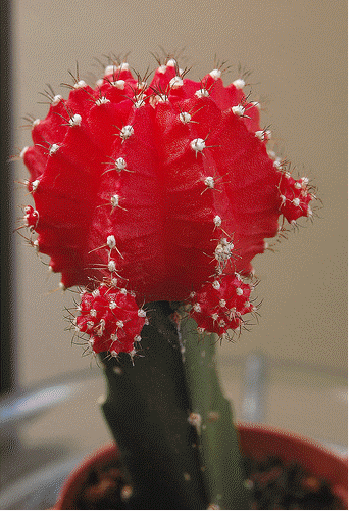 Moon
cactus is an interesting cactus is actually two plants in one. The
colorful upper portion of the cactus is a species of globular with
"chins" cactus that has no chlorophyl, allowing the other
colors to show through, typically red or orange, but because it
contains no chlorophyll, it can't survive on its own. It's grafted
onto a columnar cactus that allows it to grow and thrive. Moon
cactus is an interesting cactus is actually two plants in one. The
colorful upper portion of the cactus is a species of globular with
"chins" cactus that has no chlorophyl, allowing the other
colors to show through, typically red or orange, but because it
contains no chlorophyll, it can't survive on its own. It's grafted
onto a columnar cactus that allows it to grow and thrive.
In addition to different plant shapes, cacti also
have different types of spines. Some have long, thin spines that
radiate from the center. Another spine shape that's quite interesting
resembles a comb. The spines are arranged up and down along a long,
thin aerole. Another, almost dangerous-looking, type of spine
comprises a small group of short central spines with one long, hooked
spine coming straight out from the center. Some cactus have a small
cluster of long, pointed spines that grow straight out from the
aerole and are held almost sword-like on the plant. Not all spines on
cactus are long and pointed, though. Many are fine and hairlike, like
those that cover the "old man cactus," giving it a soft,
furry look. Some types of opuntia have a tiny cluster of very short,
almost invisible, spines that cover the aerole.
The term "succulents" is
often mentioned in the same breath with cacti. When you consider how
many different types of cacti there are in the world, and those are
all classified as succulents, plus those succulents that aren't
cacti, then you realize what a large group of plants succulents is.
Some of the most unique, diverse,
or odd succulents include sedum,
aloe,
kalanchoe,
jade plant,
and lithop.
 Succulents
are a diverse group of plants in various shapes. Even within the
same genus there are many variations. In sedum there are many types
including burro's tail,
a trailing, pale-green-leaved succulent good for hanging baskets. Also
called donkey tail or horse tail, its long stems carry cylindrical,
fleshy leaves that are pointed on the end. The leaves are just under
an inch long and less than a half inch wide. The leaves are held
closely together on the stem and overlap each other. The leaves are
pale green and covered with a whitish coating, called
"bloom." It's an ideal candidate for a hanging pot. Succulents
are a diverse group of plants in various shapes. Even within the
same genus there are many variations. In sedum there are many types
including burro's tail,
a trailing, pale-green-leaved succulent good for hanging baskets. Also
called donkey tail or horse tail, its long stems carry cylindrical,
fleshy leaves that are pointed on the end. The leaves are just under
an inch long and less than a half inch wide. The leaves are held
closely together on the stem and overlap each other. The leaves are
pale green and covered with a whitish coating, called
"bloom." It's an ideal candidate for a hanging pot.
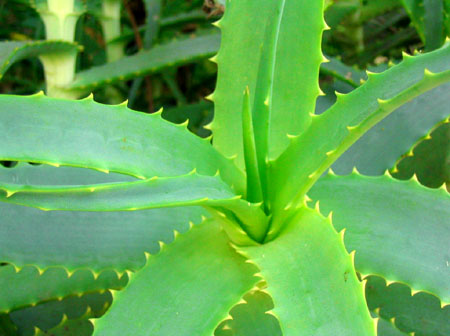 There
are many different types of aloe including Aloe
vera commonly used to soothe and heal
skin burns. Aloe vera is
often added to skin care products, but growing a plant of it on the
kitchen windowsill is a handy place to have it in the event of a skin
burn. Just simply break off a leaf, split it, and spread the juice
over the burn. There
are many different types of aloe including Aloe
vera commonly used to soothe and heal
skin burns. Aloe vera is
often added to skin care products, but growing a plant of it on the
kitchen windowsill is a handy place to have it in the event of a skin
burn. Just simply break off a leaf, split it, and spread the juice
over the burn.
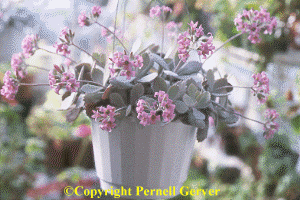 Kalanchoe
also has many forms in various shapes, sizes, colors, and textures. Kalanchoe
pumila has thick leaves that are
silver and covered with a powdery coating called "bloom."
The leaves are about an inch long and carried in rosettes on the
stems. It bears clusters of silvery-pink flowers that are carried on
thin stems that rise above the foliage. The flowers appear in mid
winter at a time when flowers are needed most indoors! The flowers
remain colorful for weeks. Kalanchoe
also has many forms in various shapes, sizes, colors, and textures. Kalanchoe
pumila has thick leaves that are
silver and covered with a powdery coating called "bloom."
The leaves are about an inch long and carried in rosettes on the
stems. It bears clusters of silvery-pink flowers that are carried on
thin stems that rise above the foliage. The flowers appear in mid
winter at a time when flowers are needed most indoors! The flowers
remain colorful for weeks.
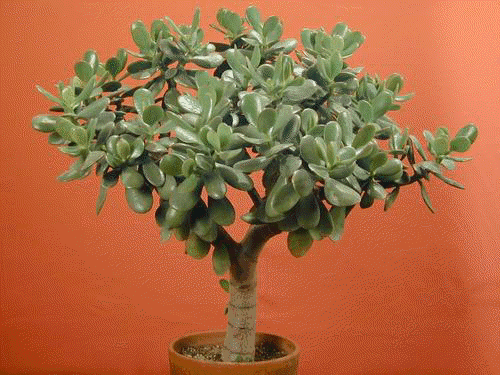 One
of the most popular succulents is the jade
plant. There are at least a half a
dozen forms of jade plant, each one of which is handsome. The common jade
plant has thick, rounded dark green
leaves attached to a swollen trunk. Old specimens can get rather
large and take on a tree-like appearance. Jade
plant also blooms. One
of the most popular succulents is the jade
plant. There are at least a half a
dozen forms of jade plant, each one of which is handsome. The common jade
plant has thick, rounded dark green
leaves attached to a swollen trunk. Old specimens can get rather
large and take on a tree-like appearance. Jade
plant also blooms.
Many succulents are considered oddities of the plant world.
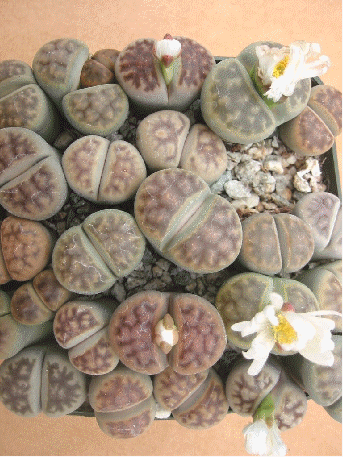 Lithops,
often called "living stones," are a curious lot of
succulents. They have actually learned to mimic stones so that they
don't get eaten. These succulents are short and stubby, less than an
inch or so wide and tall. Its succulent leaves are flat topped with
transparent “windows” that let light into the plant. Small,
white flowers appear in the center split in late summer and through
fall. During winter, new leaves form within the center of the plant.
As the new leaves grow, the Lithops,
often called "living stones," are a curious lot of
succulents. They have actually learned to mimic stones so that they
don't get eaten. These succulents are short and stubby, less than an
inch or so wide and tall. Its succulent leaves are flat topped with
transparent “windows” that let light into the plant. Small,
white flowers appear in the center split in late summer and through
fall. During winter, new leaves form within the center of the plant.
As the new leaves grow, the |



 There
are many different types of house plant cacti. They are divided into
different categories based on their individual shapes including
flattened and segmented, candelabra, columnar, cylindrical with
leaves, pendant, clustering, star shaped, globular, globular with
"chins," and pincushion.
There
are many different types of house plant cacti. They are divided into
different categories based on their individual shapes including
flattened and segmented, candelabra, columnar, cylindrical with
leaves, pendant, clustering, star shaped, globular, globular with
"chins," and pincushion.  Moon
cactus is an interesting cactus is actually two plants in one. The
colorful upper portion of the cactus is a species of globular with
"chins" cactus that has no chlorophyl, allowing the other
colors to show through, typically red or orange, but because it
contains no chlorophyll, it can't survive on its own. It's grafted
onto a columnar cactus that allows it to grow and thrive.
Moon
cactus is an interesting cactus is actually two plants in one. The
colorful upper portion of the cactus is a species of globular with
"chins" cactus that has no chlorophyl, allowing the other
colors to show through, typically red or orange, but because it
contains no chlorophyll, it can't survive on its own. It's grafted
onto a columnar cactus that allows it to grow and thrive. Succulents
are a diverse group of plants in various shapes. Even within the
same genus there are many variations. In sedum there are many types
including
Succulents
are a diverse group of plants in various shapes. Even within the
same genus there are many variations. In sedum there are many types
including  There
are many different types of aloe including
There
are many different types of aloe including  Kalanchoe
also has many forms in various shapes, sizes, colors, and textures.
Kalanchoe
also has many forms in various shapes, sizes, colors, and textures.  One
of the most popular succulents is the
One
of the most popular succulents is the 